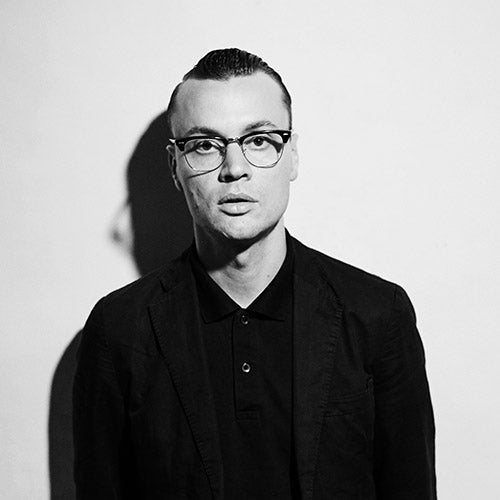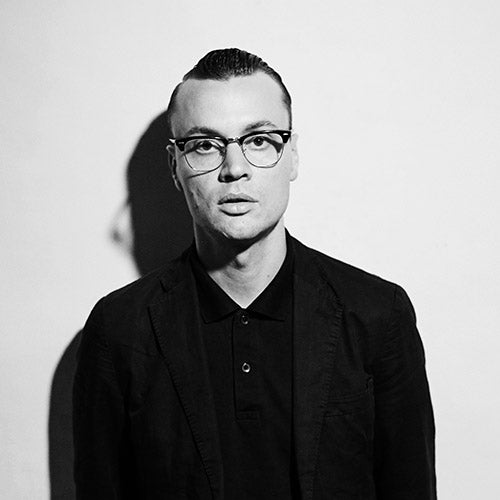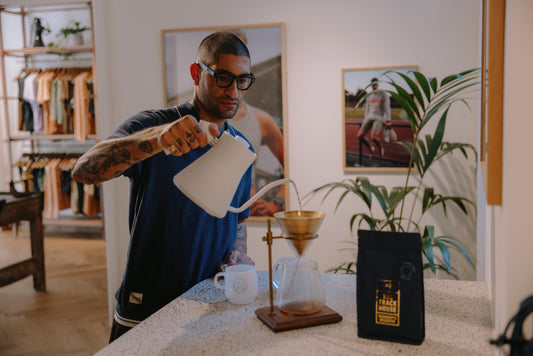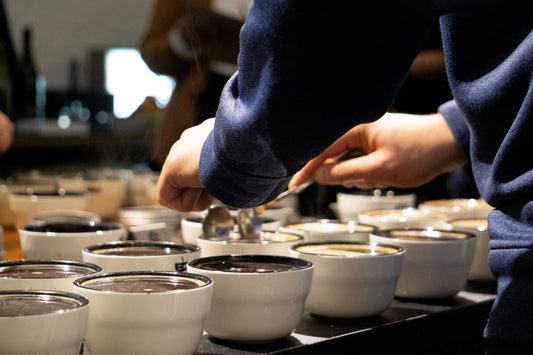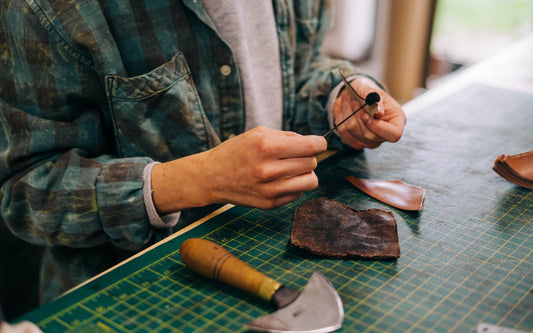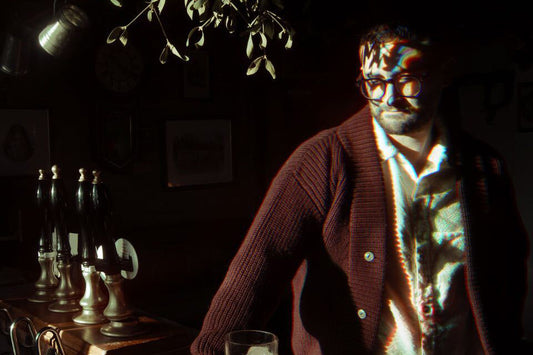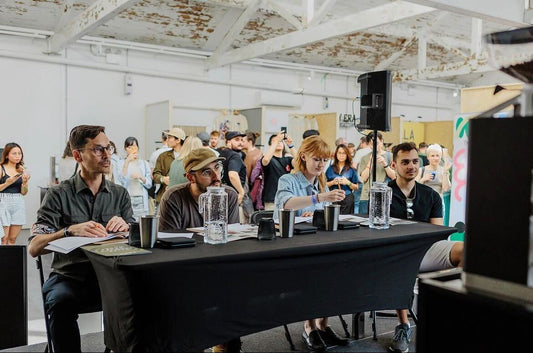
‘The best coffee possible’. A simple statement that sits at the heart of everything we do at Workshop Coffee -- from sourcing green coffee from quality-focussed farmers and producers around the world, roasting it carefully in Bethnal Green and brewing it across our coffeebars. This dedication to quality isn’t unique to us, it exists amongst other industry professionals and home hobbyists alike.
With that in mind, we’ve set out to discover and showcase individuals, organisations and initiatives, all of whom share our commitment to quality.
Kicking off the series is Jake Green, a photographer we have admired for a number of years and, more recently, collaborated with. We sat down with Jake at our White Collar Factory Coffeebar to discuss his life, his work and what the notion of quality means to him.
What’s your background?
“I grew up in London and then spent some time working and studying in Italy as a student. I picked up a camera at the age of 15 and I’ve dabbled with it ever since.”
Did you always know what type of photographer you wanted to be?
“I don’t even know that now to be honest. If I had to say, I’d say portrait, documentary, or observational - it’s what I’ve done a lot of and what I’ve really enjoyed.”
What kind of commercial work do you do?
“All sorts really. A lot of project work for global corporates, helping to bring their brand or product to life in as authentic way as possible. Sometimes I can make it look authentic and real, sometimes I can’t. It can be very frustrating when these things are very contrived. Otherwise, I do a lot of portraits and commercial music jobs, but I don’t tend to shout about that work so much. People think you can use commercial work to build your profile, but I don’t agree. Brands don’t want to see your work for other brands, they just want to see good work. It’s your [personal] project work that will sell you and it’s your project work that makes you better at your commercial work.”

Barista Baptiste Kreyder, former Head Barsita at Workshop and now currently residing in New Zealand.
What got you into coffee as a general theme for your work?
“My interest in coffee began when I moved to Italy as a teenager and started drinking good coffee for the first time. It was about the same time as the new wave of coffee started hitting London and you started to see a real change in the way people perceived it. I was developing ideas for a few personal projects at the time and I came up with this idea of ‘the first coffee of the day’ for the person who then serves coffee all day long. The funny thing is, no one actually drinks that first coffee - you’re dialling in the machine, getting the recipe right, and that’s where the name for the series Dialing In (2012) came from - a series of portraits of 10 or so really influential baristas. There was no real media output for this new coffee movement, but they were keen to spread the message of good coffee and therefore happy for me to document their work and passion. I’ll always remember when one barista said to me, “This work is going to ruin your life. You’ll never be able to drink shit coffee again.” And it’s so true, it’s become an obsession.”

James Bailey, then at Prufrock but now our Head of Quality at Workshop, photographed for ‘Dialing In’, 2012.
How was the project received?
“Overall that project went really well, but most importantly, I enjoyed it and learnt a lot. It also got placed in the FT Weekend which showed that the coffee revolution in the UK was really gaining momentum. The natural progression from there was to look into roasteries, which a lot of the top baristas I had originally met had started to set up. It’s a very tight-knit community and so once I’d photographed one barista or roastery, they would put me in touch with someone else to talk to. I shot roasters in Berlin, Paris & New York, and whenever I was travelling on a commercial assignment, I’d look up a top roaster in the same area and go photograph them.
Whilst working on the roasteries project, I remember one of the roasters saying to me ‘direct trade (of coffee) is a myth, you should go to speak to Nordic Approach’ - an exporter - who sit between the producer and the roaster. And that’s how I got into the agriculture side of the coffee - the final element which I’d never even considered.”

David Nigel Flynn of Belleville Brûlerie in Paris photographed for ‘Roasteries’, 2014.
Where do you see the coffee project moving next?
“My work with Nordic Approach (NA) has definitely piqued my interest in other global trade, so chocolate might be something I look at in the future. But first I definitely want to look at other origins. We’ve already been to Kenya, and NA are keen to document the other regions they work in. The first two projects I did - Dialing In and Roasteries - were about me starting to learn and understand coffee, so I can be in the field with top roasters, and understand what I’m taking pictures of. I want to lean on that experience and make the most of it. I’d love to do some more small bespoke books, like Beber Mi Sudor, for Kenya and Ethiopia, and then eventually do a bigger book which is more of a reference to a range of origins.”
How do you approach a big, daunting project?
“It’s a very conscious thing for me not to define a project before I start it. If you do that, you completely limit the potential of your creative output. That’s what happens with commercial work - you’re told ‘this is what the end result should look like, go and do it’. But that doesn’t make sense, that’s not how the creative process works for me. Every personal project I do is a visual research project. For example, I went to Colombia, but I didn’t know I was going to do a book. I just knew I’d get some pictures which would be useful for Nordic Approach and I’d get something interesting for myself. If I’d said before the trip ‘this is going to be a 100-page book for Phaidon’, I’d have had to had a shot list and thought about the layout of each page, and as a result the work wouldn’t have been so expressive. Something Nick Knight [a famous fashion and portrait photographer] once said was “It’s all about the process, not the end result”, and I live by that completely and utterly.

A street scene from Jake's book with Nordic Approach, sold and launched with Workshop Coffee, ‘Beber Mi Sudor’.
Where do you find inspiration for your projects?
“I think my biggest inspiration comes from reading fiction. It might give me an interesting idea, some sort of historical context or something refreshing that’s not in the mainstream. Picking up a book from the shelf that’s 50 years old is so much more likely to give you a unique perspective than any current media. Reading also lets my mind wander which is great for generating ideas, especially when you’re running around from one job to the next. There’s something to be said for taking a minute to let your mind be idle. Otherwise, I look at a lot of photography and art books and I love going to exhibitions. They’re a bit of shrine for me - there’s no advertising, no people, no screens, and I usually leave an exhibition bubbling with ideas.”
 Preacher Samuel from the series ‘The Celestials’, 2015
Preacher Samuel from the series ‘The Celestials’, 2015
How do you decide which personal project to prioritise?
“I’m very, very picky about the projects I go into now because I know how much work and commitment they’re going to require. I’ll usually prioritise projects by what interests me the most and what’s achievable sooner rather than later. For example, now I need to decide whether I’m going to go and do another origin project with Nordic Approach (Ethiopia is next), or whether I put that time and effort into doing the Kenya origin book. Or, am I going to work on my Celestials or Jehovah’s Witnesses books which I’ve also got on the go?
I’m going to start work on the Celestials project soon - do the edit, but then make a decision on the final set of images later on. I think it could be something pretty epic so I might want to give the work a couple of years to grow on me and develop. I reckon it’ll be a big, 200-page coffee table book with text and typography so I need to make sure I do it properly. I might even make some proofs of that and go to see a publisher.
The problem with that is when a publisher gets involved the whole vibe of the project can change really quickly. For example, with The Bookmakers’ Studio [Jake’s project that examines some of the world’s leading children’s bookmakers], that started as a small Kickstarter project which got funded and end up being featured on The Guardian with 20,000 shares.
Because of that, Phaidon got in touch with me and asked me to do another book, but with more people, more text, more portraits, and with people from all over the world. At first, this sounded great, but after shooting the first two artists I was done. What had originally started as this completely open-ended visual research project was now a job with a very specific endpoint, and that didn’t appeal to me at all.”
Jake photographing illustrator Jurg Lindenburger in Basel for ‘The Bookmakers’ Studio’, 2014.
You also did a project called ‘Pie & Mash’. Where did the idea for that come from?
“I was doing a series of short films about London with Simon Poon Tip who was doing a project called 32LDN, about the 32 boroughs of London. For some reason we ended up chatting about Pie & Mash shops and were both big fans, so we decided to go around London and shoot every single one. It’s a straight-up photographic documentation of something very unique to London and it picked up a nice bit of momentum online.
It was a very quick Kickstarter to raise money for the book and we doubled the target amount we wanted to raise. The goal is to get all the Pie & Mash shops registered as part of English Heritage but it’s going to be a real challenge with the high streets in the state they are.”

Nathan’s Pies and Eels photographed for Pie & Mash, 2015.
What does ‘quality’ mean to you?
“I think two things really stand out to me. For personal projects, they’re quite selfish, they’re about me projecting internally, not externally. I have to be 110% happy with it - I’m not doing these books because other people love books, I’m doing books because I love books. I want to hold it and enjoy it - and to me, that’s the ultimate mark of quality in what I do. Books to me are an interesting form of self expression - I want someone to look at one of my books and feel the same way I did when I looked at it.
Secondly, it’s all work in progress - that’s super important to me. I look at Beber Mi Sudor, for example, and I want my next book to be as good, different and maybe even better.”

Coffee cherry being loaded into a pulper hopper, from Jake’s latest project, ‘Beber Mi Sudor’.
What’s next for you?
“I want to do the Kenya book with Nordic Approach - we’ve done the trip and the images are looking good but we need some editorial to accompany it. Whereas Colombia is all about the farmers and the small holdings, Kenya is this amazing co-operative story where lots of people with a small amount of beans come together to create amazing coffee. It’s such a colourful and vibrant place and the people are so elegant and beautiful. ‘Drink My Sweat’ is actually a Swahili expression so I’m really keen to continue the series here.
I’ve got a few other personal projects bubbling around though so we’ll see what happens.”
You can find out more about Jake and his plethora of projects on his website.
Share:

